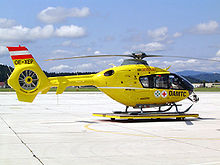| Elicopter Eurocopter EC135 |
 |
 |
| Marţi, 16 Decembrie 2014 19:23 |
|
The Eurocopter (now Airbus Helicopters) EC135 is a twin-engine civil helicopter produced by Eurocopter, widely used amongst police and ambulance services and for executive transport. It is capable of flight under instrument flight rules (IFR) and is outfitted with digital flight controls. It entered service in 1996; over a thousand aircraft have been produced to date. DevelopmentOriginsThe EC135 started development prior to the formation of Eurocopter under Messerschmitt-Bölkow-Blohm (MBB) under the designation Bo 108 by MBB in the 1970s. Working in partnership with Aerospatiale, the Bo 108 was initially intended to be a technology demonstrator, combining attributes of the successful MBB Bo 105 with new advances and an aerodynamically streamlined design. Technologies included on the Bo 108 included the first full-authority digital engine controls (FADEC) on a helicopter, a bearingless main rotor, and the adoption of a new transmission. The first prototype made its first flight on 17 October 1988, powered by two Allison 250-C20R/1 engines. A second BO 108 followed on 5 June 1991, this time with two Turboméca TM319-1B Arrius engines; unlike later production aircraft, both technology demonstrators flew with conventional tail rotors.
In the late 1990s, the design was revised with the introduction of the Fenestron tail rotor system, an advanced rigid main rotor, composite materials, and resonance isolation systems.[2] It was decided to pursue a full certification program, resulting in the production of two pre-production prototypes, under the new designation EC135 to correspond with the newly created Eurocopter company.[3] At this point, it was decided that the EC135 should be developed with two competing engines, the Turboméca Arrius 2B and the Pratt & Whitney Canada PW206B engines; both engines proved to be successful and either is available as options on production EC135s. The EC135 made its first public appearance in January 1995 at the Heli-Expo at Las Vegas. European JAA certification was achieved on 16 June 1996, with FAA approval following on 31 July. Further development
Superior Ambulance's EC135 at Rush University Medical Center
Single-pilot IFR (SPIFR) certification was granted by the German LBA on 2 December 1999. Deliveries to the German Aviators Corps began on 13 September 2000 at the German Army Aviators School at Bückeburg Air Base. The EC135 received SPIFR certification from the UK CAA in December 2000. In 2000, Eurocopter announced the start of certification work for the Pratt & Whitney Canada PW206B2, a version of the PW207 which offers improved single-engine performance and 30 second emergency power. The LBA certification was achieved on 10 July 2001, and the first EC135 with the new engines was handed over to the Swedish National Police on 10 August 2001. In 2002, the EC135 Active Control Technology demonstrator/Flying Helicopter Simulator (ACT/FHS), a research aircraft designed to test fibre optic-based flight control systems, undertook its first flight.[5] At the NBAA in March 2007 in Atlanta, Eurocopter unveiled ‘L’Hélicoptère par Hermès, a special-edition VIP model designed by Hermès International, S.A.. This variant features a specially created luxury four-place main cabin, a sliding glass partition, a corporate baggage hold, redesigned skid landing gear and other external changes. Launch customer for ‘L’Hélicoptère par Hermès is Falcon Aviation Services (FAS), based in Abu Dhabi, United Arab Emirates. In 2011, Eurocopter entered the Chinese business market licensing the Zhong-Ou International Group to produce the EC135 Luxury Helicopter in the Province of Zhejiang. Operational historyDeliveries started on 1 August 1996, when two helicopters (0005 and 0006) were handed over to Deutsche Rettungsflugwacht. The 100th EC135 was handed over to the Bavarian police force in June 1999; by which point the worldwide fleet had accumulated approximately 30,000 flight hours. The world fleet leader in aircraft hours for this type is G-NESV (s/n 0067) operated by Cleveland Police Air Operations Unit based at Durham Tees Valley Airport, UK. This aircraft was originally delivered to the North East Air Support Unit in April 1999, and by 2009 it had clocked up almost 12,000 hours. In 2011, Eurocopter announced that a total of 1000 EC135 helicopters had been delivered to customers worldwide, roughly 15 years following the start of production. In 2009, the EC135 was the first aircraft selected for offshore wind support in the UK after the Civil Aviation Authority approved helicopter operations to the Greater Gabbard offshore wind farm. The EC135 has also been used for this purpose in Denmark, supporting the Horns Rev offshore wind farm where over 10,000 successful personnel transfers have taken place. In 2013, it was reported that the EC135 was currently providing roughly 25% of the world's total emergency medic services flights, and that over 500 EC135s have been delivered to in an aeromedical configuration. In October 2014, the Australian Department of Defence announced that the EC135 would be procured as the primary training platform for both the Australian Army and Royal Australian Navy. Variants
Cornwall Air Ambulance EC135 G-KRNW overhead at Polzeath, August 2008

EC135 T2 air ambulance of the Austrian Air Rescue service in Klagenfurt, Austria

A Eurocopter EC135 of the German Brandenburg State Police

An ADAC EC135 taking off from Bonn University Clinic
OperatorsThe EC135 is popular with air charter companies, air ambulance operators and is operated by private individuals and companies. Government operators
Military Operators
EC135 T1 of the German Army
Accidents and incidents
Specifications (EC135 P2+/T2+)Data from Eurocopter EC135 2008 Tech Data book General characteristics
Performance
See also
** sursa - wikipedia |






























